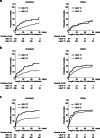Significance of body temperature in elderly patients with sepsis
- PMID: 32605659
- PMCID: PMC7329464
- DOI: 10.1186/s13054-020-02976-6
Significance of body temperature in elderly patients with sepsis
Abstract
Background: Elderly patients have a blunted host response, which may influence vital signs and clinical outcomes of sepsis. This study was aimed to investigate whether the associations between the vital signs and mortality are different in elderly and non-elderly patients with sepsis.
Methods: This was a retrospective observational study. A Japanese multicenter sepsis cohort (FORECAST, n = 1148) was used for the discovery analyses. Significant discovery results were tested for replication using two validation cohorts of sepsis (JAAMSR, Japan, n = 624; SPH, Canada, n = 1004). Patients were categorized into elderly and non-elderly groups (age ≥ 75 or < 75 years). We tested for association between vital signs (body temperature [BT], heart rate, mean arterial pressure, systolic blood pressure, and respiratory rate) and 90-day in-hospital mortality (primary outcome).
Results: In the discovery cohort, non-elderly patients with BT < 36.0 °C had significantly increased 90-day mortality (P = 0.025, adjusted hazard ratio 1.70, 95% CI 1.07-2.71). In the validation cohorts, non-elderly patients with BT < 36.0 °C had significantly increased mortality (JAAMSR, P = 0.0024, adjusted hazard ratio 2.05, 95% CI 1.29-3.26; SPH, P = 0.029, adjusted hazard ratio 1.36, 95% CI 1.03-1.80). These differences were not observed in elderly patients in the three cohorts. Associations between the other four vital signs and mortality were not different in elderly and non-elderly patients. The interaction of age and hypothermia/fever was significant (P < 0.05).
Conclusions: In septic patients, we found mortality in non-elderly sepsis patients was increased with hypothermia and decreased with fever. However, mortality in elderly patients was not associated with BT. These results illuminate the difference in the inflammatory response of the elderly compared to non-elderly sepsis patients.
Keywords: Body temperature; Elderly; Fever; Hypothermia; Septic shock.
Conflict of interest statement
The authors declare that they have no competing interests.
Figures



Comment in
-
Hyperthermia is a predictor of high mortality in patients with sepsis.Crit Care. 2020 Sep 3;24(1):543. doi: 10.1186/s13054-020-03263-0. Crit Care. 2020. PMID: 32883332 Free PMC article. No abstract available.
-
Mortality in non-elderly septic patients was increased with hypothermia and decreased with fever while mortality in elderly patients was not associated with body temperature: beware of some confounders!Crit Care. 2020 Oct 13;24(1):606. doi: 10.1186/s13054-020-03316-4. Crit Care. 2020. PMID: 33050916 Free PMC article. No abstract available.
References
Publication types
MeSH terms
LinkOut - more resources
Full Text Sources
Medical

